
Two small disks A and B of mass 3 kg and 1.5 kg, respectively, may slide on a horizontal, frictionless surface. They are connected by a cord, 600 mm long, and spin counterclockwise about their mass center G at the rate of 10 rad/s. At t = 0, the coordinates of G are
'
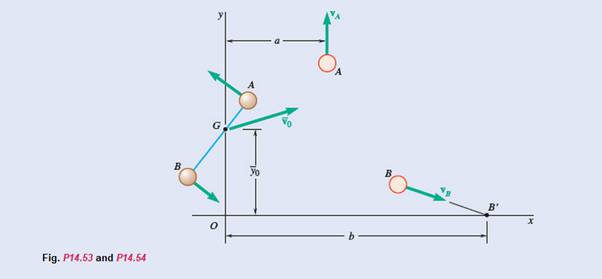
(a)
The velocities of disks A and B after the cord breaks.
Answer to Problem 14.53P
Explanation of Solution
Given information:
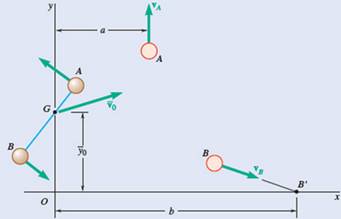
Mass of the disk A,
Mass of the disk B,
Length of cord
At t=0,
Co-ordinates of G are
Velocity
Distance
Firstly, calculate for initial condition.
The free body diagram for initial condition is as follows:
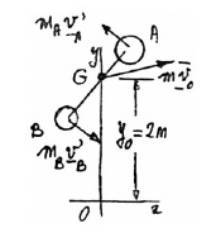
The distance G from points A and B,
And,
Now, considering linear momentum,
After breaking the disks moves counter clockwise about their mass centre G, at the rate of 10 rad/sec.
Hence, angular momentum of both the disc about G,
Again, angular momentum of both the disc about point O,
Here, the property of determinant
Now, kinetic energy of the component is,
Calculation:
After the cord is break then the free body diagram of both disc A and B.

Using conservation of mass of linear momentum,
Equation the coefficient of i :
Equation the coefficient of j :
Applying conservation of energy,
Substituting the values from equation (1) and (2);
By solving the above equation we get;
Hence, velocity of A,
And velocity of B,
(b)
The distance a from the y-axis to the path of A.
Answer to Problem 14.53P
Explanation of Solution
Given information:
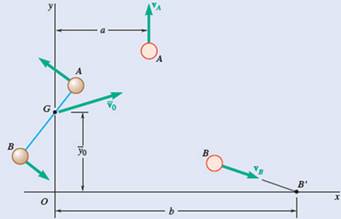
Mass of the disk A,
Mass of the disk B,
Length of cord
At t=0,
Co-ordinates of G are
Velocity,
Distance
Firstly, calculate for initial condition.
The free body diagram for initial condition is as follows:
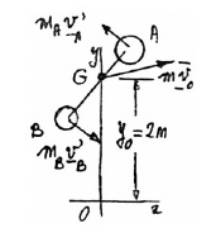
The distance G from points A and B,
And,
Now, considering linear momentum,
After breaking the disks moves counter clockwise about their mass centre G, at the rate of 10 rad/sec.
Hence, angular momentum of both the disc about G,
Again, angular momentum of both the disc about point O,
Here, the property of determinant
Now, kinetic energy of the component is,
Calculation:
After the cord is break then the free body diagram of both disc A and B.
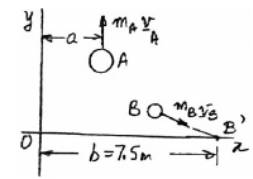
Using conservation of mass of linear momentum,
Equation the coefficient of i :
Equation the coefficient of j :
Applying conservation of energy,
Substituting the values from equation (1) and (2);
By solving the above equation we get;
Hence, velocity of A,
And velocity of B,
Now, Conservation of angular momentum about O,
Want to see more full solutions like this?
Chapter 14 Solutions
Vector Mechanics For Engineers
- Three small spheres A, B, and C , each of mass m , are connected to a small ring D of negligible mass by means of three inextensible, inelastic cords of length I . The spheres can slide freely on a frictionless horizontal surface and are rotating initially at a speed v0 about ring D which is at rest. Suddenly the cord CD breaks. After the other two cords have again become taut, determine (C ) the speed of ring D, (b) the relative speed at which spheres A and B rotate about D , (c) the fraction of the original energy of spheres A and B that is dissipated when cords AD and BD again became taut.arrow_forwardTwo identical giant flywheels are on 2 identical slopes at an angle alpha = 20 deg. One flywheel is rolling on its inside shaft of diameter d1 = 3 ft, and the second flywheel is rolling without slipping on its outside diameter d2 = 5 ft. They are both released from rest. The weight of the flywheel is W = 8 lbs 1. Knowing that flywheel 1 attains a speed of v = 7.0 ft/s in t = [t] s, (if t doesn't show take any t between 5 and 10 sec) find the radius of gyration of the flywheels, following those steps: 3. What will be the distance between the 2 flywheels? Which one is in front? a. Explain your strategy to find the distance made by each wheel. b. Find the 3 distances made by each wheel. c. Find the distance between the 2 flywheels. d. Why one is in front? 4. Using flywheel 2, what is the coefficient of static friction between the outside diameter and the ground required to prevent slipping? a. Using the 3 previous diagrams, which impulse will you consider finding the force of…arrow_forwardQUESTION: A bowling ball ( m₁ = 3.00 kg and radius of r = 50.0 mm) which has an angular and linear velocity of 57.1 rad/s and 2.85 m/s, respectively, rolls without sliding and hits a slender Bar B of mass m_2 = 1.00 kg and length L = 0.12 m, which is initially at rest as shown in the following figure. Neglecting the friction between the sphere and the bar, and knowing the coefficient of restitution between the sphere and the bar is 0.2, determine (1) the angular velocity of Sphere A and Bar B immediately after impact, and (2) the linear velocities of sphere A and bar B immediately after impact (and at their centroids). ANSWER: Answers I got are: (they are wrong :< need help) Angular velocity of Sphere A immediately after impact: -/+ 3.34 rad/s (both are wrong) Angular velocity of Bar B immediately after impact: 8.09 rad/s The linear velocity of sphere A immediately after impact (and at the centroid) : 0.16 rad/s2 or 0.485 rad/s2 (both wrong) The linear velocity of Bar B…arrow_forward
- Two identical giant flywheels are on 2 identical slopes at an angle alpha = 20 deg. One flywheel is rolling on its inside shaft of diameter d1 = 3 ft, and the second flywheel is rolling without slipping on its outside diameter d2 = 5 ft. They are both released from rest. The weight of the flywheel is W = 8 lbs Knowing that flywheel 1 attains a speed of v = 7.0 ft/s in t = [t] s, (if t doesn't show take any t between 5 and 10 sec) find the radius of gyration of the flywheels, following those steps: b. Find omega final c. Find the angular impulse at the point of contact between the shaft and the slope. d. Write the formula to find the final momentum. e. Solve for k, using the principle of angular impulse and momentumarrow_forwardA 1024-kg blue ball is dropped from an initial z-position of 5.4 x 106 m through the center of a planet with radius 6.3 x 106 m. If the mass of the planet is 37.7 x 1015 kg, measure the displacement of the ball at time t = 5 s?arrow_forwardA cyclist is riding a bicycle at a speed of 20 mph on a horizontal road. The distance between the axles is 42 in., and the mass center of the cyclist and the bicycle is located 26 in. behind the front axle and 40 in. above the ground. If the cyclist applies the brakes only on the front wheel, determine the shortest distance in which he can stop without being thrown over the front wheel.arrow_forward
- A particle of mass 2.6 kg is attached to two cables CB and CA as shown. it revolves in a horizontal circle of radius 1.3 m at a constant speed of 8.45 m/s.arrow_forwardTwo smooth disks A and B each have a mass of 0.5 kg. Both disks are moving with the velocities shown when they collide. Suppose that (vA)1 = 9 m/s , (vB)1 = 8 m/s. The figure shows two discs, A and B, moving toward the origin of a horizontal xy-plane, where they collide, so that their common tangent lies on y-axis. Disk A moves in negative x-direction with velocity left-parenthesis v subscript A right-parenthesis subscript 1. Block B moves from the third quarter with velocity left-parenthesis v subscript B right-parenthesis subscript 1, directed along an inclined line with a slope of four-thirds. Determine the coefficient of restitution between the disks if after collision B travels along a line, 30∘ counterclockwise from the y axis.arrow_forwardA 1.8-kg collar A and a 0.7-kg collar B can slide without friction on a frame, consisting of the horizontal rod OE and the vertical rod CD, which is free to rotate about its vertical axis of symmetry. The two collars are connected by a cord running over a pulley that is attached to the frame at O. At the instant shown, the velocity vA of Collar A has a magnitude of 2.1 m/s and a stop prevents collar B from moving. The stop is suddenly removed and collar A moves toward E. As it reaches a distance of 0.12 m from, the magnitude of its velocity is observed to be 2.5 m/s. Determine at that instant the magnitude of the angular velocity of the frame and the moment of inertia of the frame and pulley system about CD.arrow_forward
- A bowling ball ( m₁ = 3.00 kg and radius of r = 50.0 mm) which has an angular and linear velocity of 57.1 rad/s and 2.85 m/s, respectively, rolls without sliding and hits a slender Bar B of mass m_2 = 1.00 kg and length L = 0.12 m, which is initially at rest as shown in the following figure. Neglecting the friction between the sphere and the bar, and knowing the coefficient of restitution between the sphere and the bar is 0.2, determine (1) the angular velocity of Bar B immediately after impact, and (2) the linear velocities of sphere A and bar B immediately after impact (and at their centroids).arrow_forwardEnds of three light identical rods each of length l are connected to a light pivot that enables them to rotate in any direction. At the other ends of the rods, three particles A, B and C of masses m, 2m and 3m respectively are affixed. Initially the rods are coplanar, angle between any two is 120 and the particles are at rest. Now the particle C is given a velocity u perpendicular to the rod connected to it and in the plane of the rods as shown in the figure. Ignore gravitational interaction between the particles. What are the moduli of acceleration of the particles A, B and C immediately after the particle C is given velocity u?arrow_forwardA 1.6-kg tube AB can slide freely on rod DE which in turn can rotate freely in a horizontal plane. Initially the assembly is rotating with an angular velocity of magnitude w = 5 rad/s and the tube is held in position by a cord. The moment of inertia of the rod and bracket about the vertical axis of rotation is 0.30 kg.m2 and the centroidal moment of inertia of the tube about a vertical axis is 0.0025 kg.m2If the cord suddenly breaks, determine (a) the angular velocity of the assembly after the tube has moved to end E, (b) the energy lost during the plastic impact at E.arrow_forward
 Elements Of ElectromagneticsMechanical EngineeringISBN:9780190698614Author:Sadiku, Matthew N. O.Publisher:Oxford University Press
Elements Of ElectromagneticsMechanical EngineeringISBN:9780190698614Author:Sadiku, Matthew N. O.Publisher:Oxford University Press Mechanics of Materials (10th Edition)Mechanical EngineeringISBN:9780134319650Author:Russell C. HibbelerPublisher:PEARSON
Mechanics of Materials (10th Edition)Mechanical EngineeringISBN:9780134319650Author:Russell C. HibbelerPublisher:PEARSON Thermodynamics: An Engineering ApproachMechanical EngineeringISBN:9781259822674Author:Yunus A. Cengel Dr., Michael A. BolesPublisher:McGraw-Hill Education
Thermodynamics: An Engineering ApproachMechanical EngineeringISBN:9781259822674Author:Yunus A. Cengel Dr., Michael A. BolesPublisher:McGraw-Hill Education Control Systems EngineeringMechanical EngineeringISBN:9781118170519Author:Norman S. NisePublisher:WILEY
Control Systems EngineeringMechanical EngineeringISBN:9781118170519Author:Norman S. NisePublisher:WILEY Mechanics of Materials (MindTap Course List)Mechanical EngineeringISBN:9781337093347Author:Barry J. Goodno, James M. GerePublisher:Cengage Learning
Mechanics of Materials (MindTap Course List)Mechanical EngineeringISBN:9781337093347Author:Barry J. Goodno, James M. GerePublisher:Cengage Learning Engineering Mechanics: StaticsMechanical EngineeringISBN:9781118807330Author:James L. Meriam, L. G. Kraige, J. N. BoltonPublisher:WILEY
Engineering Mechanics: StaticsMechanical EngineeringISBN:9781118807330Author:James L. Meriam, L. G. Kraige, J. N. BoltonPublisher:WILEY





